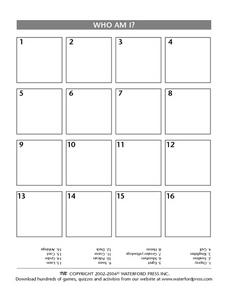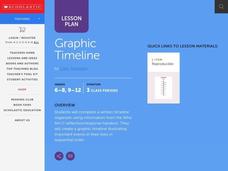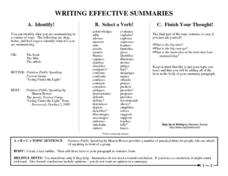Curated OER
Using the Correct Form of To Be
In this using the correct form of to be instructional activity, students interactively complete 15 sentences using am, is, or are with immediate online feedback.
Curated OER
Math: Am I Prime?
Seventh graders determine the difference between prime and composite numbers. On a Website, they discover a method to identify all the prime numbers up to 100 and also complete several online activities. Once they have discussed the...
Curated OER
Where in My World Am I?
Students determine exactly where they are in the world by using a local map to write accurate directions to local eating establishments. They write precise directions from the school to their home which the teacher simulates driving to...
Curated OER
¿Ser o Estar?
¿Ser o estar? That is the question! These two are often confused, and if your learners really want to develop their language skills, they need to know the difference! Use this reference sheet to thoroughly explain each ver. The chart...
Curated OER
El verbo Ser-Explanation and Practice 1
The Spanish verb ser is one of the most important verbs for your beginning speakers to learn. This resource is stellar! First, there's a verb chart explaining the forms of the verb, then there's a fill-in-the blank practice section, and...
Curated OER
Who Am I? Tropical Plants and Animals
In this science worksheet, students examine 16 detailed pictures of tropical plants and animals. Students identify each species. There is no room to write the name under the picture. It is assumed this is an oral activity, although...
Curated OER
Who Am I?
In this science worksheet, students examine 16 detailed pictures of different species of marine invertebrates. Students identify each species. There is no room to write the name under the picture. It is assumed this is an oral activity,...
Curated OER
Who Am I? Bird Species
In this science worksheet, pupils examine 16 detailed color pictures of bird species. Students identify each bird. There is no room to write the bird name on the paper and it is assumed that this is an oral activity. Answers are provided...
Curated OER
Graphic Timeline
Students complete a written timeline organizer utilizing information from the "Who Am I?" reflection/response handout. They create a graphic time line illustrating important event in their lives in sequential order with the help of...
Curated OER
Ecology 12 Human Effects
Students are able to respond to a reading passage concerning human effects (under development) in Madagascar. They have a quiz on primary and secondary succesion as their bell ringer. Students write an essay on the topic "No man is an...
Curated OER
Counting
Second graders comprehend how to use two different kinds of graphs. They complete a worksheet with the help of the teacher and a bag of jellybeans and then another worksheet without the direction of the teacher. Students listen as the...
Curated OER
Present Simple 'Yes/No' Questions with 'Be'
Teach your class how to use the verb "to be" properly in sentences with this worksheet. For this activity, learners compose questions using the present simple forms of to be such as is, are, and am. The directions are limited, so you...
Curated OER
Lesson Plan for Scaffolding Complex Texts
Enhance a class read-aloud of the children's story Hi! Fly Guy with this reading comprehension lesson. Children first listen as the teacher reads the story, stopping along the way to discuss any unfamiliar vocabulary. The book is then...
Study Champs
Punctuation
Practice punctuation with a quick exercise. Class members fill in either a period or a question mark at the end of each of 14 sentences. A brief explanation of when to use a period versus a question mark is included.
Anchorage School District
Writing Effective Summaries
Drafting a strong first sentence for a summary is an important step. Writers can use the formula presented on this handout to get started. The resource lists three steps to put together a strong topic sentence, as well as tips and hints...
Planet e-Book
Oliver Twist
"Please, sir. May I have some more?" An eBook version of Oliver Twist by Charles Dickens introduces readers to the text that inspired the classic line. An oldie but a goodie, book worms see why this novel is so beloved.
Center for Civic Education
Responsibility and the U.S. Constitution
When are responsibilities freely chosen, and when have they actually been imposed on us? Here you'll find a unique way to frame your class discussion on civic duty and responsibilities inherent in the United States Constitution.
It's About Time
Organizing a Store
When provided with multiple objects, how many ways can the class organize and display them based on predetermined factors? Assist class members with a handy activity—theoretically teaching them concepts to understand periodic table...
Curated OER
Correct Uses of the Verb "Be"
Useful for an intermediate to advanced ESL class, as well as a standard Language Arts class, this grammar presentation guides learners through the forms of "be." Slides detailing the present tense singular and plural, as well as past...
Curated OER
The Present & Imperfect Progressive
Starting off with present participles, this resource tackles the progressive with grammatical explanations, examples in English and Spanish, and an interactive practice exercise. Use the menu at the top of the webpage to navigate to each...
Curated OER
Metaphor Meanings
Help your young writers decipher the literal meanings of metaphors. After reading several metaphors, learners write the real meanings that the phrases are describing. Use this resource in a figurative language lesson, or when preparing...
K12 Reader
Metaphors Compare Things
This worksheet on metaphors is your ticket to better writing! As learners read ten sentences, they underline the metaphor and circle the two objects of comparison.
Curated OER
English Abbreviations That are Derived from Latin - Matching Worksheet
In this language arts worksheet, students match abbreviations that are used in the English language but come from Latin derivatives. They draw a line from 19 abbreviations to their definitions.
Curated OER
Who Is Who?
In this who is who worksheet, students draw a line from 6 people who are speaking on the sides of the worksheet to the word that best describes each one in the middle. Students answer 3 short answer questions at the bottom of the worksheet.

























